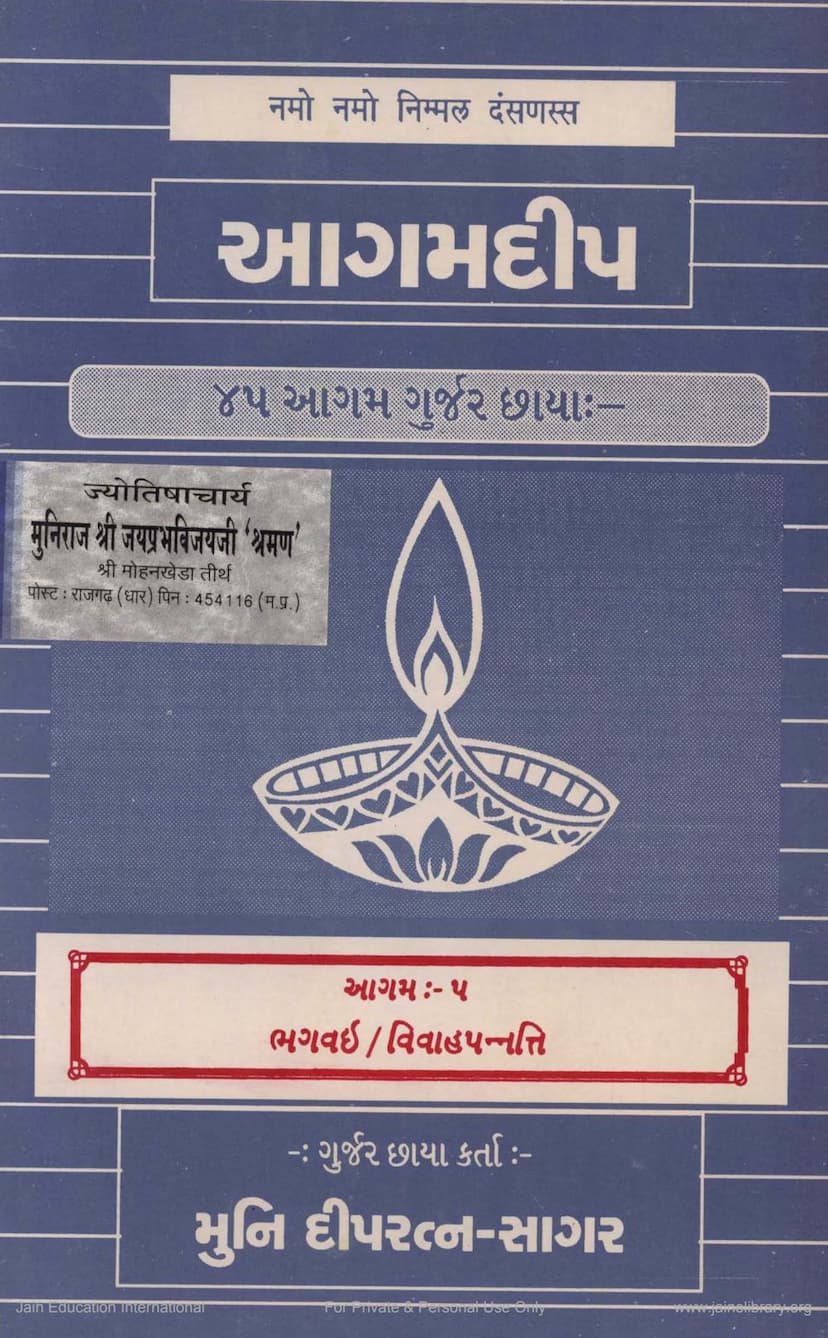Agam Deep Agam 05 Gujarati Anuvaad Part 2
Added to library: September 1, 2025

Summary
This text, "Agam Deep Agam 05 Gujarati Anuvaad Part 2" by Dipratnasagar and Deepratnasagar, is the Gujarati translation and commentary (Anuvaad and Gurjar Chhaya) of the fifth Anga of the Jain Agamas, the Vivaha Pannatti (also known as Bhagwati Sutra). The provided text specifically covers the Gujarati translation part (Anuvaad) and commentary part (Gurjar Chhaya) of Agam 5, specifically Vivaha Pannatti, Volume 5, part 2.
The text itself is a detailed transcript of a question-and-answer session between Lord Mahavir (Bhagwan Mahavir) and his chief disciple, Gautam Swami (also referred to as Indrabhuti). This particular section, covering Chapters 1 through 14 (numbered as Shatak 1 to Shatak 15 in the text), delves into a vast array of Jain philosophical and cosmological concepts.
Here's a breakdown of the key themes and topics covered in the text, based on the chapter summaries and content:
Core Jain Concepts Discussed:
- The Nature of Existence: The text explores the fundamental nature of existence, including the definition and properties of Pudgala (matter), Agam (Jain Agamas), Jiva (soul/living beings), Ajiva (non-living entities), and Akasha (space).
- Cosmology: It details the structure of the universe (Lok and Alok), including the different Lokas (universes), Pṛthivi (earthly realms/hells), Deva-lokas (heavenly realms), Vimanas (celestial mansions), and the celestial bodies like the Sun and Moon, their movements, and their interactions. The text goes into significant detail about the structure and dimensions of these realms, including the various hellish regions (Naraka) and their inhabitants (Nairayika).
- Karma Theory: A significant portion of the text is dedicated to the complex Jain theory of Karma. It elaborates on the different types of karma (Jñānāvaraṇīya, Darśanāvaraṇīya, Vedanīya, Mohaniya, Āyuṣya, Nām, Gotra, and Antarāya), how they are bound, their effects, and the processes of their shedding (Nirjara). The interaction between soul and karma, including the role of intention (pramāda) and action (yoga), is discussed extensively.
- The Soul (Jiva): The text discusses the soul in various states – as Sajñī (conscious) and Asajñī (unconscious), Sajñi-Asajñī (partially conscious/unconscious), Sa-kṣāya (with passions) and Nir-kṣāya (without passions), Sa-yogī (with karma-related activities) and Nir-yogī (without such activities), Bandha (bondage), Moksha (liberation), and the different types of knowledge and perception (Jñāna and Darśana).
- The Soul's Journey: It traces the soul's transmigration through various life forms (Naraka, Tiryanch, Manushya, Deva) based on its karma, actions, and intentions. The concept of Bhavya (liberable) and Abhavya (non-liberable) souls is also touched upon.
- Jain Ethics and Practices: The text discusses the importance of Karma in determining future births and the consequences of actions. It implicitly or explicitly refers to practices like Sanyam (restraint), Tapa (penance), Ahimsa (non-violence), and the stages of spiritual progress. The interaction of ascetics (anagar, muni, nirgrantha) with the world and their adherence to vows is described.
- The Nature of Phenomena: It explains various concepts like Upayoga (application/consciousness), Sandhya (twilight), celestial phenomena, the nature of physical substances (Pudgala) and their transformations, and the role of Karmavargaṇā (karmic matter).
- The Role of Kevali and Spiritual Teachers: The text highlights the omniscience of Kevalins (fully enlightened beings) and the role of Acharyas and Upadhyayas in guiding disciples. It shows Lord Mahavir's (or his disciples' in the persona of answering questions) profound knowledge in answering complex queries.
- Specific Jain Texts and Concepts: The text makes references to other important Jain scriptures like Prajnapti Sutra and Jivabhigam Sutra, indicating its place within the broader Jain canon. It also discusses specific Jain concepts like Karmic Vargaṇā, Pudgala, Samyak Darshan, Samyak Charitra, and the different types of Jñāna (knowledge) and Darśana (perception).
Structure and Presentation:
The text is presented as a dialogue between Lord Mahavir and Gautam Swami, where Gautam Swami asks questions about various aspects of Jain philosophy, and Lord Mahavir (or through him, Gautam Swami's interpretation) provides detailed answers. The author, Muni Deepratnasagar, provides a Gujarati translation and commentary (Chhaya), making the complex philosophical concepts accessible in Gujarati. The text is organized into Shatakas (books/sections) and Udesas (chapters/sections within a Shataka), indicating a systematic exploration of topics. The sheer volume of questions and answers suggests a comprehensive treatment of the subject matter.
Overall Purpose:
The overall purpose of this text is to elucidate the teachings of Jainism as found in the Agamas, particularly the Vivaha Pannatti. It serves as an educational tool for Jain followers, offering deep insights into their cosmology, philosophy, and the path to liberation, presented in an accessible Gujarati translation and commentary. The text highlights the intricate workings of karma, the nature of existence, and the path to spiritual purity as understood within the Jain tradition.
In summary, "Agam Deep Agam 05 Gujarati Anuvaad Part 2" (which is part of the larger "Agam Deep Prakashan" series) is a profound Jain scripture, specifically a translation and commentary on the Vivaha Pannatti, presenting a vast array of teachings through a dialogue between Lord Mahavir and Gautam Swami, covering cosmology, karma, the nature of the soul, ethics, and the path to liberation.